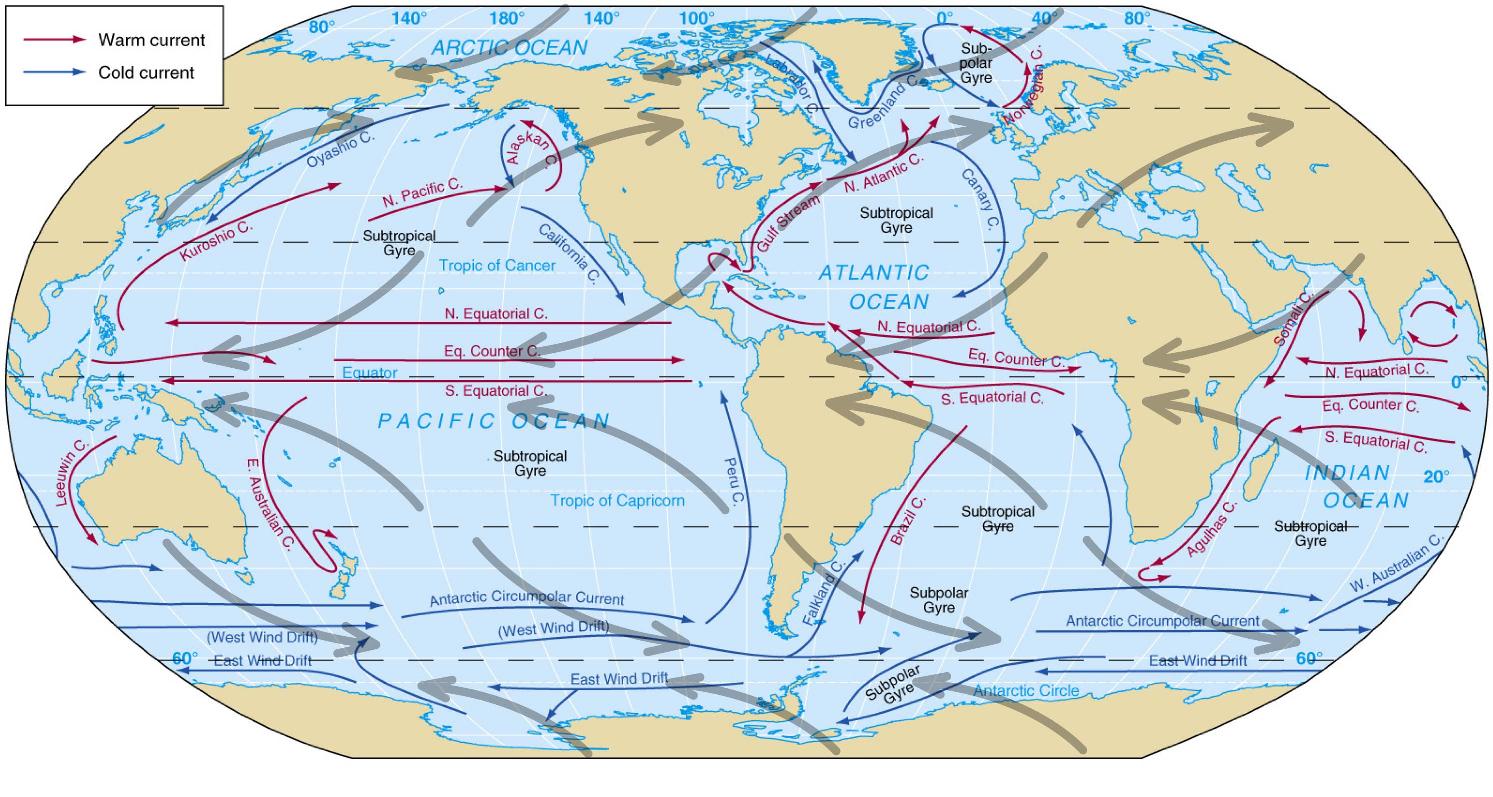Ocean Currents can be a confusing topic. Understanding the complete mechanism and various interrelationships in play when it comes to ocean currents can be overwhelming. The following visualisation by NASA will help you understand the role of ocean and ocean currents. Many terms and themes discussed here will be taken up in subsequent sections.
Ocean Currents are influenced by 2 kinds of forces.
- Primary or Causation forces – that initiate the movement of water.
- Secondary forces – that modify the flow of the waters.
Primary forces
Ocean is driven by the atmosphere above it in 2 ways
1.Wind Stress or Frictional Drag – Friction between wind and oceans creates a frictional drag known as wind-stress. It impacts the upper 100m of the ocean surface and sets the water in motion.
2.Insolation – Heating by solar energy. The heating causes water to expand.
>Causes water to expand. In the equatorial regions, the height is 8cm higher. This causes a slight gradient and water tends to flow down the slope.
>Causes precipitation and evaporation which changes the salinity and hence the density of water.
Secondary forces
1.Coriolis Force – The effects of this force has been discussed in atmospheric circulations. It causes winds to deflect toward the right in the Northern Hemisphere and toward the left in the Southern Hemisphere, resulting in curved paths. It has a similar impact on Ocean Currents deflecting them to the right in the Northern Hemisphere and to the left in the Southern Hemisphere.
2.Gravity – Gravity acts of the density difference of water. Density is a function of temperature and salinity and insolation, precipitation and evaporation plays an important role.
3.Shape of the ocean basin –
*NCERT somewhat differs in its definition of Primary and Secondary forces, but the above classification is apter.
Types of Ocean Currents
There are 2 types of Ocean Currents
1. Surface Currents also called Wind-Driven Currents
The Surface Currents are a result of the Wind-stress and are modified by Coriolis force. Hence Surface currents mimic Atmospheric Wind Circulations. The diagram below shows how Easterlies are inline with equatorial current, the Westerlies are inline with Kuroshio and Gulf Stream.
Ocean currents are constrained by the continental masses that border the three major oceans. This causes slight variations in their movement.

To understand the mechanism, we touch upon few concepts.
Ekman Spiral
Ekman Spiral is the result of Coriolis force on the movement of surface water. The wind-stress moves the uppermost layer of water. This layer, in turn, drags the layer below it. Each deeper layer moves more slowly than the layer above it until the movement ceases at a depth of about 100 meters.
All layers of water are deflected by Coriolis force to the right in the Northern Hemisphere and to the left in the Southern Hemisphere. As a result, each successive layer moves 45 deg. to the direction of drag force being applied. The diagram below captures this aptly. This creates a twisting effect creating the spiral. The spiral is known as Ekman Spiral and each subsequent layer is called the Ekman Layer.
The average movement of all the layers comes out to be 90 deg to the direction of the surface wind.

Gyres
Ekman Spiral give rise to ‘Gyres’. These are ocean-circling currents that occur north and south of the equator. They do not occur at the equator, where the Coriolis effect is not present. There are five in all: two in the Pacific – north, and south of the equator, two in the Atlantic, and one in the Indian Ocean, south of the equator. In the northern Indian Ocean, the landmasses of Asia prevent the formation of a full gyre. Instead, there is a seasonally reversible current, driven by the Monsoon winds.
Surface ocean currents are further divided into warm and cold currents
2. Deep-water Currents also called Thermohaline Currents –
While wind effects drive ocean currents in the upper 100 meters of the ocean’s surface, ocean currents also flow thousands of meters below the surface. These deep-ocean currents are driven by differences in the water’s density, which is controlled by temperature (thermo) and salinity (haline). This process is known as thermohaline circulation.
Cold, salty water is dense and sinks to the bottom of the ocean and eventually returns to the surface through mixing. On a global scale, this sinking and rising of ocean water creates what scientists call the ‘great ocean conveyor belt.’
Case Study: The Gulf Stream
Gulf Stream is where you don’t see a clear-cut distinction between the Wind-Driven and Thermohaline.The first part of the Gulf Stream that represents the warm waters to a certain extent are Wind Driven


